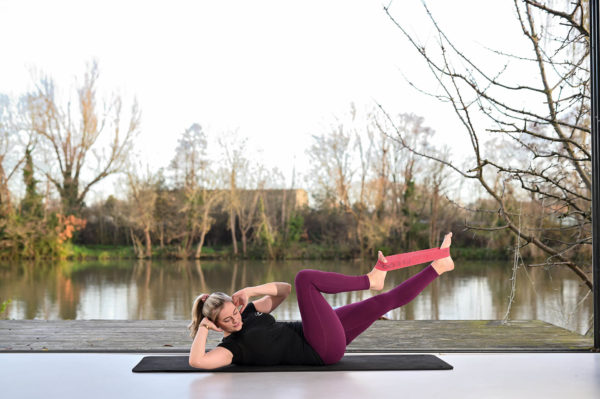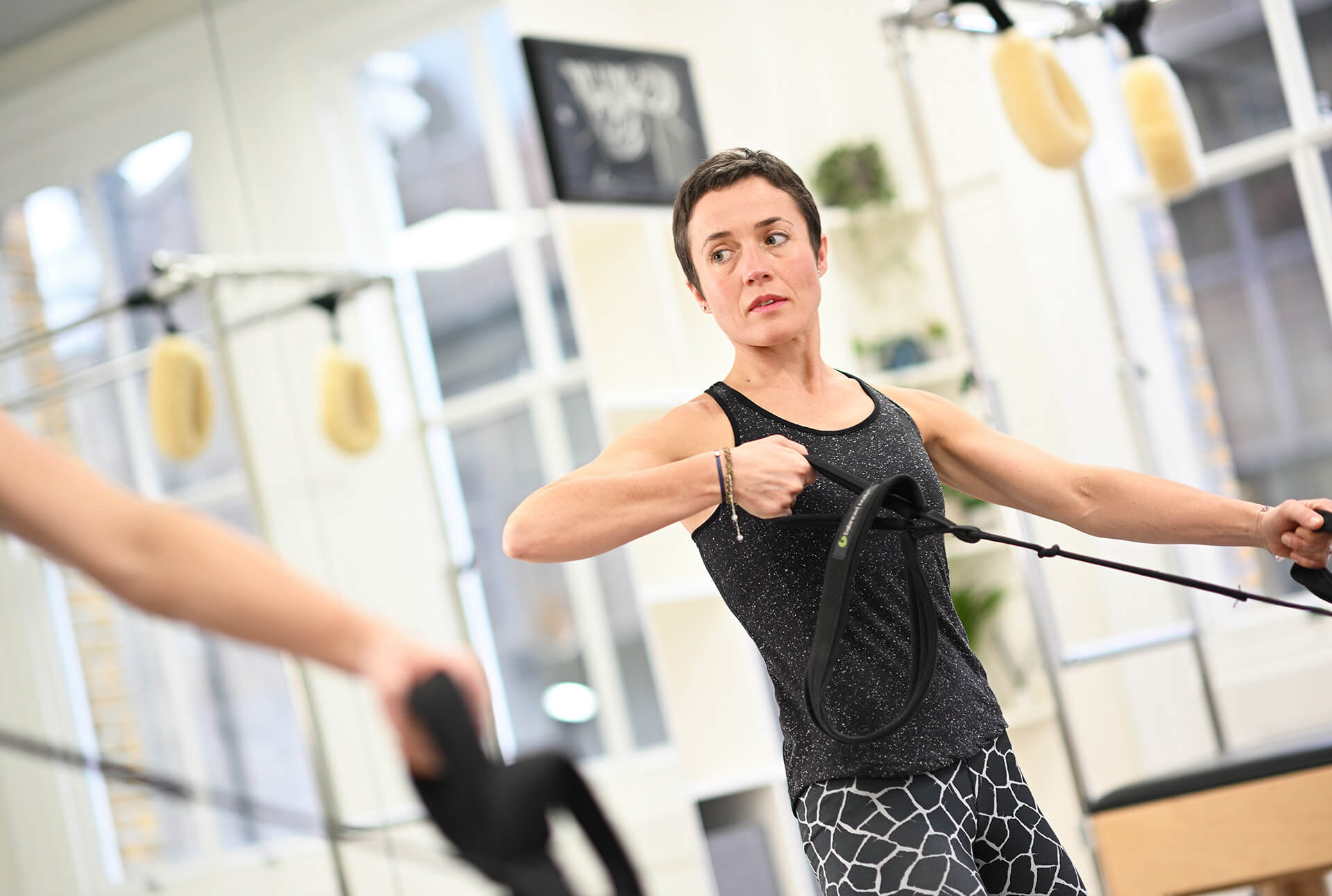Are you looking to build your abs strength? Do you want a warm-up exercise before you run or play sports? Maybe you just want a challenge?
The criss cross exercise is an excellent movement to help with building strength in the core. It’s carried out on a mat and focuses on the abdominals with an emphasis on the obliques (the waist muscles!)
In this article, we’ll be discussing:
- What is a criss cross?
- How to do the criss cross Pilates exercise?
- What are the benefits of the criss cross exercise?
- Who is the criss cross exercise suitable for / not suitable for?
What is a criss cross?
The criss cross exercise is an effective abdominal and oblique exercise which helps towards body awareness, posture and spinal flexibility thanks to the lift and twisting action. If you are looking to build your abdominal or hip flexor strength or need a warm-up exercise before you run or play sports, then the criss cross Pilates exercise is perfect for that.
The obliques play a part in posture stabilisation, but they are more involved in flexion and rotation of the spine.
Purposes of criss cross:
- Challenges the abdominal muscles, especially the obliques!
- Works the hip flexors.
- Challenges your awareness of breath
- Works the stabiliser muscles around the shoulder blade
Precision Points:
- Try to keep your pelvis level as you rotate
- Keep your elbows in your peripheral vision and your shoulder blades relaxed on your rib cage.
- Breathe evenly throughout the movement
- Stay up as you go through the middle to rotate.
How to do Criss Cross exercise in Pilates
- Lie on your back in a neutral spine
- Bend your knees and raise your legs into table top (hips at 90 degrees, knees at 90 degrees).
- Place your hands behind your head, let your elbows settle into your periphery.
- Use your arms to lift your head off the floor and send your gaze to your thighs.
- As you exhale, reach one leg out long until the knee is straight and the foot is pointed. At the same time, twist your torso towards the opposite knee.
- Inhale as you move through the middle
- Exhale as you switch sides, extending the other leg and rotating towards the opposite direction.
- Repeat for up to 45 seconds!
Top Tips
★ Keep the elbows in your peripheral vision with your head in line with your breast bone. This way you will know how much you are rotating rather than cheating and just moving your neck!
★ Imagine your ribs are rotating around your spine.
★ Try to keep the pelvis quiet and level rather than rocking from side to side.
★ Try to keep the bent leg in table top rather than bringing it towards you to try and make the elbow touch the knee.
★ As you come through the centre, try to lift up and through rather than dropping back down.
★ Try to avoid pushing your lower back to the floor. If you keep your breath going and allow your stomach to rise and fall, your lower back will naturally sink towards the floor as your whole spine will be a flexion
★ If you have a lower back problem, as you extend the leg, keep it higher. The stronger you become, the lower the leg will be able to go.
What are the benefits of criss cross?
There are a number of benefits to the criss cross exercise. It works on the abdominal muscles, in particular the internal and external obliques. These muscles run diagonally along your sides from the lower ribs to the tops of the hip bones. They turn on when compressing and forward bending the abdomen as well as bending and twisting the torso to the side.
Strengthening these muscles helps ensure you are doing a complete abdominal workout. In daily life, you need strong obliques to help you with bending and twisting movements.
Benefits of criss cross include:
- helps with body awareness and posture.
- strengthens the hip flexors which are often weak in people
- challenges pelvic stability and control
- works the obliques which not only helps build a strong core, but also helps define the waist!
- challenges your entire core system and breathing mechanics
- assists and improves your Pilates practice as the twisting movement is commonly used in other Pilates exercises.

Who is criss cross suitable for?
Criss cross is ideal for anyone who is looking to build up abdominal strength and work on their pelvic stability. It’s an especially great exercise if you are a runner or play a lot of sports where a strong core is essential to help with performance and prevent injury.
Who is criss cross not suitable for?
If you have osteoporosis or a confirmed back problem, it is best to avoid this exercise and speak to your GP or a physiotherapist. If you have any back or neck pain when doing this exercise, it is worth reaching out or speaking to your physiotherapist to find out if this exercise is right for you. It’s also best to avoid this exercise after the first trimester of pregnancy. There are lots of other abs exercises you can do so you won’t be missing out!
Like with most exercises, if your form starts to suffer, it’s likely that your muscles are tired. Poor form will inevitably lead to injury. If criss cross isn’t working for you then you should consult with an exercise specialist such as a Clinical Pilates Instructor for individual, tailored advice.
Why do a Criss Cross?
In summary, the criss cross exercise is a great way to strengthen all abdominal and core muscles and work on those obliques which in turn assists with posture and the ability to flex and rotate the torso,
At Complete Pilates, we would advise you to always speak to your doctor or physiotherapist before starting a new exercise routine, especially if you have any health concerns or are new to fitness.
If you would like more information on the criss cross Pilates exercise and would like to know how to incorporate this into your exercise regime then our team of clinical Pilates instructors here at Complete Pilates can help. They are trained to safely treat clients and create manageable, on-going exercise plans to keep you healthy.
Get in touch online or contact us on 0203 764 5668 for further information.
Education is key:
These blogs are designed to give information to everyone, however, it is important to remember that everyone is different! If you have not seen one of our therapists and have any questions about injuries, what you have read or whether this may be useful to you, please just ask. We are more than happy to help anyone and point you in the right direction. Our biggest belief is that education is key. The more you understand about your injury, illness and movement, the more you are likely to improve.




